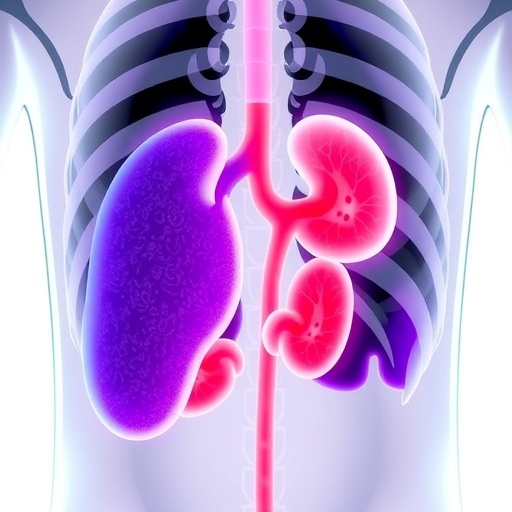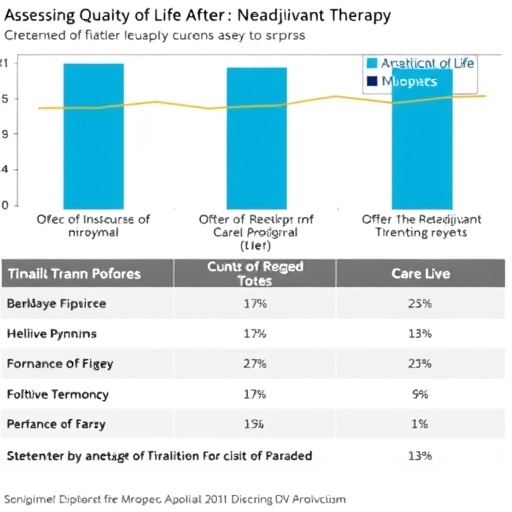In a groundbreaking retrospective multicenter study, researchers have illuminated the prognostic significance of the C-reactive protein–albumin–lymphocyte (CALLY) index in patients battling metastatic renal cell carcinoma (mRCC). Renal cell carcinoma, notorious for its aggressive nature and poor prognosis once metastasized, has long eluded precise biomarker-based prognostication. The emergence of the CALLY index as a reliable predictor offers a beacon of hope in stratifying patients and tailoring therapeutic strategies more effectively.
The CALLY index represents an innovative amalgamation of three critical biomarkers reflecting systemic inflammation and immune status: serum albumin, absolute lymphocyte count, and C-reactive protein (CRP). Serum albumin, a well-established marker of nutritional status and systemic health, often declines in chronic illness. Lymphocyte count serves as a surrogate for immune competence, while CRP is a sensitive indicator of systemic inflammatory activity. By integrating these parameters, the CALLY index encapsulates the complex interplay between nutrition, immune function, and inflammation that influence cancer progression and patient survival.
The researchers meticulously analyzed data from 95 patients diagnosed with metastatic renal cell carcinoma, calculating the CALLY index using the formula: serum albumin level (g/dL) multiplied by absolute lymphocyte count (cells/µL), divided by C-reactive protein (mg/dL), then multiplied by 10,000. Using maximal log-rank statistical analysis, the team identified an optimal cutoff value of 0.12 that dichotomized the cohort into two distinct prognostic groups.
.adsslot_W0PbaS3zLg{ width:728px !important; height:90px !important; }
@media (max-width:1199px) { .adsslot_W0PbaS3zLg{ width:468px !important; height:60px !important; } }
@media (max-width:767px) { .adsslot_W0PbaS3zLg{ width:320px !important; height:50px !important; } }
ADVERTISEMENT
Strikingly, patients with a CALLY index below 0.12 exhibited a median overall survival (OS) of merely 11.1 months, in stark contrast to 45.7 months in those with an index at or above 0.12. This immense disparity underscores the CALLY index’s potent discriminative power in predicting patient outcomes. Similarly, progression-free survival (PFS) was significantly longer in the high-index cohort, with median PFS reaching 33.1 months compared to just 7.1 months for the low-index group.
The robustness of these findings was further strengthened through Cox regression analyses, which accounted for confounding factors and identified a CALLY index below 0.12 as an independent prognostic factor. Specifically, low CALLY values were associated with a hazard ratio (HR) of 0.41 for overall survival and 0.40 for progression-free survival, both reaching strong statistical significance. This independent association suggests the CALLY index’s potential utility in clinical decision-making beyond traditional prognostic indicators.
Understanding the pathophysiological basis for the CALLY index’s predictive capability requires delving into the tumor microenvironment and systemic host response. Chronic inflammation is recognized as a catalyst for tumorigenesis, promoting DNA damage, angiogenesis, and immune evasion. Elevated CRP levels reflect this pro-tumorigenic inflammation. Concurrently, hypoalbuminemia indicates poor nutritional and inflammatory states, both of which can weaken host resilience against cancer progression. Lymphopenia, or reduced lymphocyte count, signifies compromised adaptive immunity, hampering the body’s ability to mount effective anti-tumor responses.
Integrating these markers into a single index, therefore, captures the multifaceted biological processes driving tumor behavior and host susceptibility. The CALLY index elegantly bridges clinical laboratory data with cancer biology, translating complex interactions into actionable prognostic information. Its simplicity and reliance on routinely available laboratory parameters enhance its appeal for widespread clinical application.
Renal cell carcinoma frequently exhibits resistance to conventional chemotherapy and radiotherapy, placing immense emphasis on immunotherapy and targeted therapies in treatment regimens. Identifying patients with poor prognosis early can steer clinicians toward more aggressive or experimental approaches, while sparing others from undue treatment-related toxicity. The CALLY index, validated in this study, may serve as a cornerstone for risk stratification frameworks in mRCC.
Despite these promising results, the study acknowledges limitations inherent to retrospective designs and sample size constraints. Prospective large-scale studies are imperative to validate the CALLY index’s predictive accuracy across diverse populations and treatment paradigms. Additionally, exploring the index’s dynamic changes during therapy may reveal insights into treatment responsiveness and disease monitoring.
In the broader landscape of oncology, the CALLY index may transcend renal cell carcinoma, offering prognostic insight in other malignancies characterized by inflammation-driven progression. Prior studies have hinted at its utility in gastrointestinal, lung, and hematological cancers, suggesting a universal relevance that warrants further exploration. Its integration into multi-parameter prognostic models combining molecular and clinical data could revolutionize personalized cancer management.
From a practical perspective, implementing the CALLY index requires minimal resources, as serum albumin, lymphocyte counts, and CRP levels are standard components of cancer patient workups. This cost-effectiveness enhances its potential adoption, especially in resource-limited settings where advanced molecular profiling remains inaccessible. It democratizes prognostic assessment, fostering equity in cancer care.
The study also stimulates discussion on the underlying biological interplay among nutrition, immunity, and inflammation in cancer outcomes. It reiterates the necessity for holistic patient management encompassing nutritional support, infection control, and immune modulation alongside oncologic therapies. Such multidisciplinary strategies could synergistically improve the CALLY index and, by extension, patient prognosis.
In conclusion, this pioneering research positions the C-reactive protein–albumin–lymphocyte (CALLY) index as a potent independent prognostic biomarker in metastatic renal cell carcinoma. It encapsulates critical aspects of host-tumor interplay in a single, measurable parameter, enabling stratification of patient survival outcomes with remarkable precision. While further validation is needed, the CALLY index heralds a promising advance in the quest to personalize cancer prognosis and treatment strategies.
Subject of Research: Prognostic biomarker evaluation in metastatic renal cell carcinoma using the C-reactive protein–albumin–lymphocyte (CALLY) index
Article Title: Prognostic utility of the C-reactive protein–albumin–lymphocyte (CALLY) index in metastatic renal cell carcinoma
Article References:
Akgüner, G., Altınbaş, M. Prognostic utility of the C-reactive protein–albumin–lymphocyte (CALLY) index in metastatic renal cell carcinoma. BMC Cancer 25, 1347 (2025). https://doi.org/10.1186/s12885-025-14767-9
Image Credits: Scienmag.com
DOI: https://doi.org/10.1186/s12885-025-14767-9
Tags: CALLY index metastatic kidney cancercancer progression patient survivalimmune competence cancer prognosisinflammatory markers kidney cancernutritional status chronic illness cancerpredictive models for metastatic cancerprognostic biomarkers renal cell carcinomarenal cell carcinoma treatment outcomesretrospective multicenter study kidney cancerserum albumin lymphocyte count CRPsystemic inflammation immune status cancertailored therapeutic strategies mRCC





